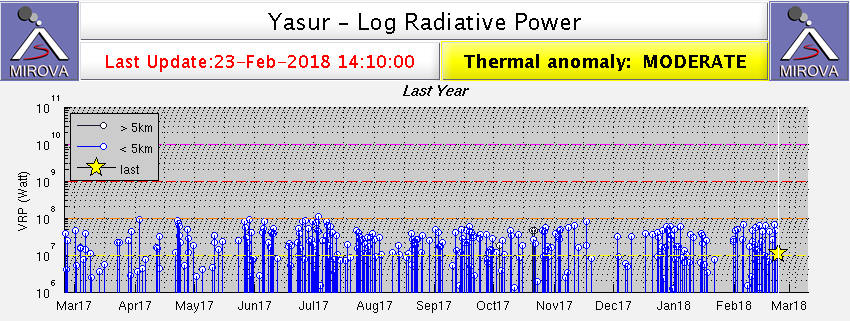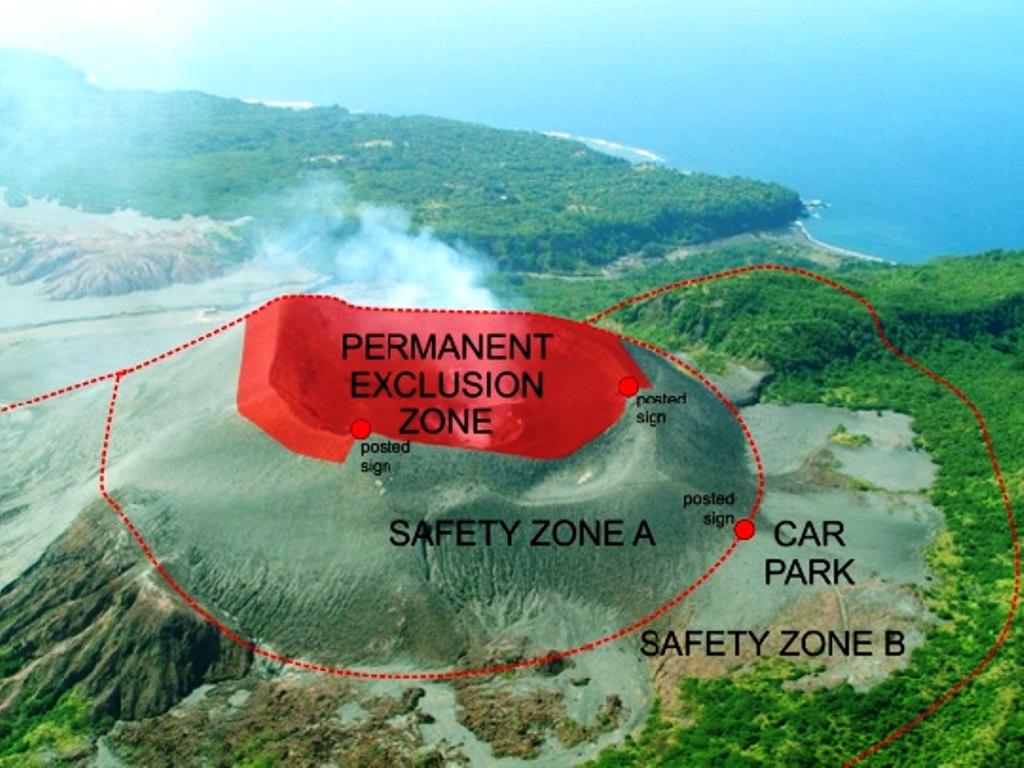Report on Yasur (Vanuatu) — February 2018
Bulletin of the Global Volcanism Network, vol. 43, no. 2 (February 2018)
Managing Editor: Edward Venzke.
Research and preparation by Paul Berger.
Yasur (Vanuatu) Typical ongoing eruptive activity and thermal anomalies through January 2018
Please cite this report as:
Global Volcanism Program, 2018. Report on Yasur (Vanuatu) (Venzke, E., ed.). Bulletin of the Global Volcanism Network, 43:2. Smithsonian Institution. https://doi.org/10.5479/si.GVP.BGVN201802-257100
Yasur
Vanuatu
19.532°S, 169.447°E; summit elev. 361 m
All times are local (unless otherwise noted)
Regular monitoring reports about Yasur from the Vanuatu Meteorology and Geo-Hazards Department (VMGD) indicated that the centuries-long eruptive activity continued from mid-June 2017 through January 2018. VMGD volcano bulletins on 21 July, 30 August, 29 September, 31 October, and 8 December 2017, and 30 January 2018, stated that major unrest was continuing, and the Alert Level remained at 2 (on a scale of 0-4). Based on seismic data, explosions continued to be intense. Visitors were reminded of the closed 395-m-radius Permanent Exclusion Zone (figure 47) and that volcanic ash and gas could impact other areas near the volcano due to trade winds.
During the reporting period thermal anomalies based on MODIS satellite instruments analyzed using the MODVOLC algorithm were numerous every month. The MIROVA (Middle InfraRed Observation of Volcanic Activity) system also detected numerous hotspots every month (figure 48).
 |
Figure 48. Thermal anomalies detected in MODIS data by the MIROVA system (log radiative power) at Yasur for the year ending 23 February 2018. Courtesy of MIROVA. |
Geological Summary. Yasur has exhibited essentially continuous Strombolian and Vulcanian activity at least since Captain Cook observed ash eruptions in 1774. This style of activity may have continued for the past 800 years. Located at the SE tip of Tanna Island in Vanuatu, this pyroclastic cone has a nearly circular, 400-m-wide summit crater. The active cone is largely contained within the small Yenkahe caldera, and is the youngest of a group of Holocene volcanic centers constructed over the down-dropped NE flank of the Pleistocene Tukosmeru volcano. The Yenkahe horst is located within the Siwi ring fracture, a 4-km-wide open feature associated with eruption of the andesitic Siwi pyroclastic sequence. Active tectonism along the Yenkahe horst accompanying eruptions has raised Port Resolution harbor more than 20 m during the past century.
Information Contacts: Geo-Hazards Division, Vanuatu Meteorology and Geo-Hazards Department, Ministry of Climate Change Adaptation, Meteorology, Geo-Hazards, Energy, Environment and Disaster Management, Private Mail Bag 9054, Lini Highway, Port Vila, Vanuatu (URL: http://www.vmgd.gov.vu/, https://www.facebook.com/VanuatuGeohazardsObservatory/); Radio New Zealand (URL: https://www.radionz.co.nz); Hawai'i Institute of Geophysics and Planetology (HIGP) - MODVOLC Thermal Alerts System, School of Ocean and Earth Science and Technology (SOEST), Univ. of Hawai'i, 2525 Correa Road, Honolulu, HI 96822, USA (URL: http://modis.higp.hawaii.edu/); MIROVA (Middle InfraRed Observation of Volcanic Activity), a collaborative project between the Universities of Turin and Florence (Italy) supported by the Centre for Volcanic Risk of the Italian Civil Protection Department (URL: http://www.mirovaweb.it/).


